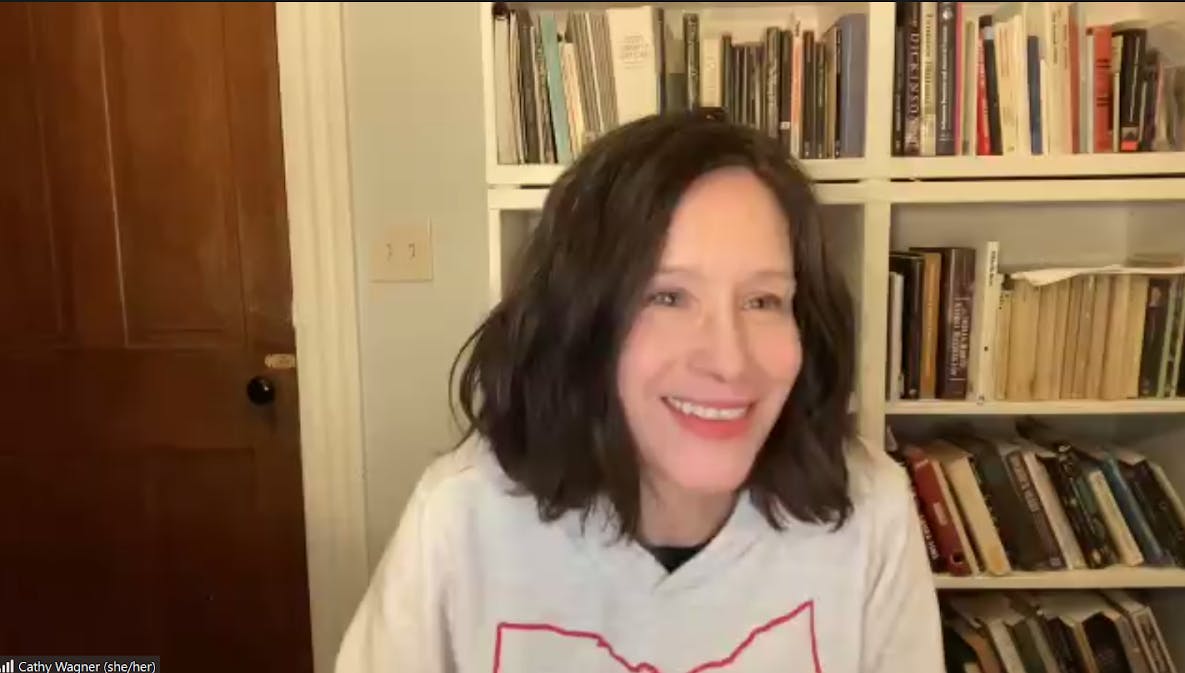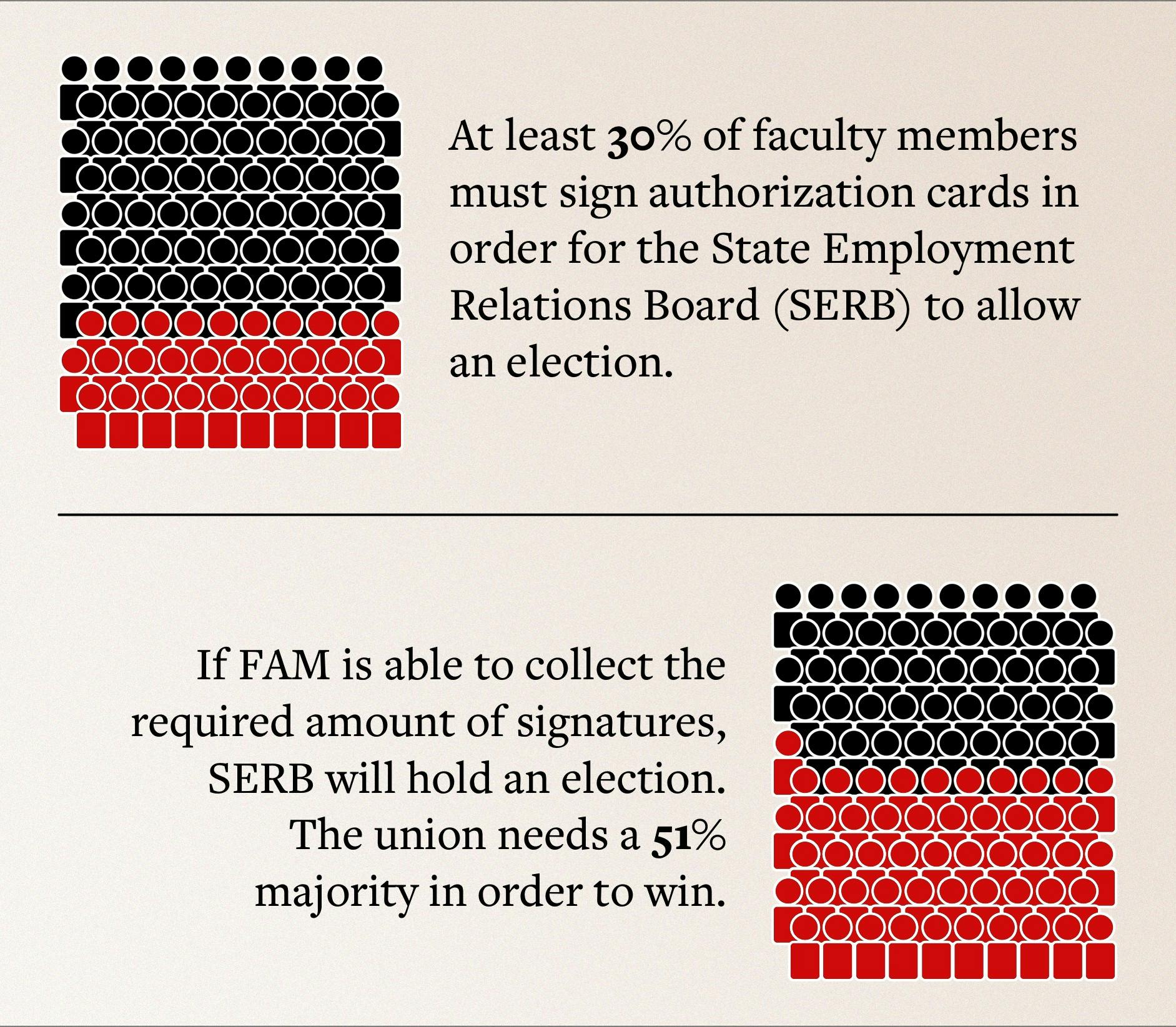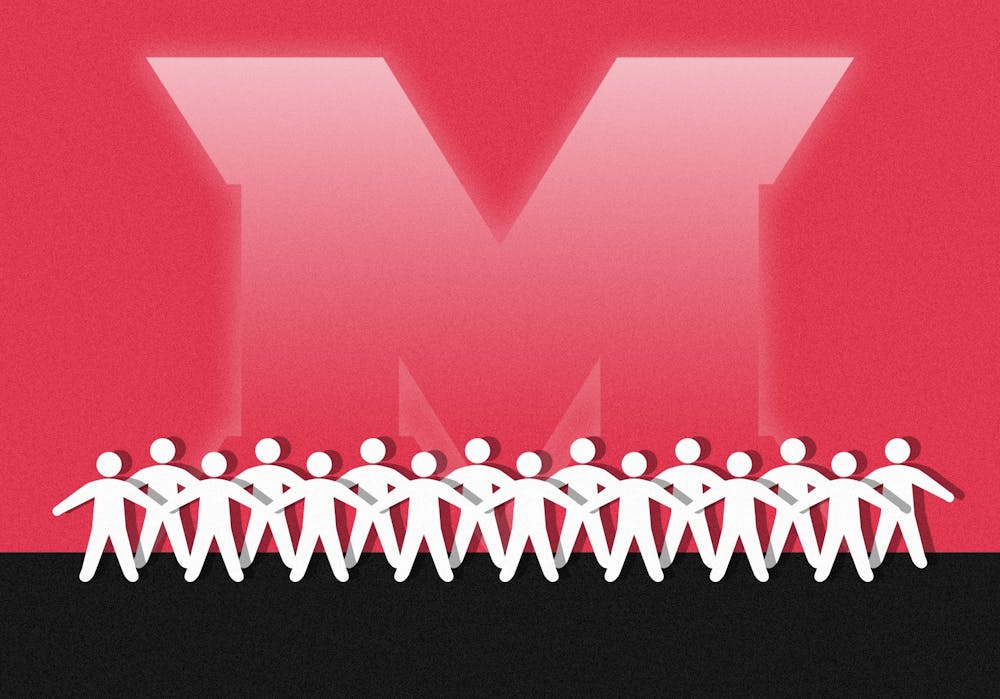Editor's Note: This story has been updated to include a statement from Miami University.
The announcement of unionization did not come quickly for Cathy Wagner, president of Miami University’s chapter of the American Association of University Professors (AAUP). She’s been working on her plan to introduce collective bargaining to Miami faculty for two years.
AAUP announced its campaign for a faculty union, named Faculty Alliance of Miami (FAM), on Wednesday, Feb. 2 during a chapter meeting. Wagner, along with a handful of committee members, has been spearheading the push behind the scenes since April 2020.
Now, she believes FAM has garnered enough support to finally let the entire Miami community in on it. Up until Feb. 2, Wagner had been keeping her plans away from Miami administration’s ear.
“We have the numbers to know that if we had a vote tomorrow, we could win,” Wagner said. “So we're gonna go ahead and go forward with the public phase of the campaigns and, you know, get out there.”
In an email sent to The Miami Student, Jessica Rivinius, director of News and Media Relations, said Miami administration is "deeply committed" to its system of shared governance at Miami.
"We value our productive and positive relationship with our primary university governing body, University Senate, which is a democratic body and reservoir of knowledge composed of students, faculty, staff, and administrators where we discuss university issues and through true collective decision-making arrive at conclusions on the policies and actions of the university," Rivinius wrote. "We are highly committed to the success of our faculty, staff, and students as we work together to achieve our student-centered mission."
Wagner said most professors hadn’t had unionization on their minds until April 2020, when Miami administration announced visiting assistant professors (VAPs) would not be renewed for the next semester.
According to the Office of Institutional Research and Effectiveness (OIRE), in fall 2019, Miami employed about 1,420 full-time faculty members. By fall 2020, that number had been reduced by 21%.
In response to the announcement, AAUP began writing and collecting signatures on a petition that called for an alternative to losing the VAPs.
Wagner said the petition gathered about 800 signatures in under 24 hours. However, Miami administration did not change its decision.
“It just wasn't responded to at all,” Wagner said. “I think that was really the match that lit the fire. People were pretty upset, and a lot of folks started talking about unionizing.”
Enjoy what you're reading?
Signup for our newsletter
After speaking with a few professors around campus, Wagner decided to begin formally campaigning for a union at Miami. She identified a few passionate professors and formed an organizing committee.
The committee is made up in part by professors Michelle Boone, Mary Jean Corbett, Todd Edwards and Mack Hagood.
For the next two years, the committee began meeting with faculty members from Miami’s main and regional campuses over Zoom and in person. In these meetings they learned what faculty felt were major issues on campus as well as whether they’d be interested in unionizing.
Boone, an associate professor of biology at Miami, spoke with many faculty over the phone, Zoom and on walks through her neighborhood.
“I found that so heartening to talk with other people, because I was in a dark place with what was happening at work,” Boone said. “And so it was super helpful just to hear what other people are going through.”
Boone said her conversations were a safe space for her and other faculty to share how they felt about the pandemic and subsequent job losses.
“Some people just felt like they hadn't talked with anybody about it and people would cry in our conversations,” Boone said. “So it just actually felt really good to be reaching out to people and saying, like, ‘Hey, you know, we can do something like if we join together, we can … build a better Miami.’”
Now that Wagner believes her committee has garnered enough support to go public with the campaign, more faculty can join the conversation.
“We've talked to an enormous number of people,” Corbett, a university distinguished professor of English, said. “And the overwhelming majority of the people we've talked to are for unionization.”

Cathy Wagner, American Association of University Professors (AAUP) president, is heading the push for unionization at Miami.
Reasons For Unionization
Throughout the canvassing process, many professors brought up the same issues: Miami’s teacher-scholar model, shared governance, salary and working conditions.
The teacher-scholar model, Wagner said, is what attracted many faculty to Miami. The model encourages faculty to spend time on both teaching and research.
“I think what a lot of us love about Miami is that it's a place where we can do [research] and where students are involved in that, and we can work closely with our students on that,” Wagner said. “And so it's a place where it's just a really unusual model where teaching is taken very seriously, and scholarship and research is taken very seriously.”
At other institutions, faculty may be asked to focus more on one or the other.
“When you're a teacher at Ohio State … you're going to be judged on your research,” Wagner said. “Your teaching is secondary.”
Corbett said the model was challenged when VAPs were not renewed and professors experienced an increase in course loads.
Edwards, professor of mathematics education, said his wife was one of the VAPs who was not renewed. He and his wife, both Miami alumni, chose Miami because of its unique teacher-scholar model.
“You can have that personal sort of touch while still working with world class people, and so I don't want that to go away,” Edwards said. “And I sort of see it under threat right now.”
Corbett said when she came to Miami in 1989, she was most interested in the teacher-scholar model as well.
“I think it's important that we renew our commitment to the relationship between scholarship and teaching,” Corbett said, “which means that we be encouraged to continue to do our research. I feel that lots of faculty don't think they have time to do their research anymore.”
Miami separates its faculty into three categories: tenure, tenure-track, and non-tenured track. Faculty who have been tenured can’t be fired without cause or extraordinary circumstances. Tenure-track faculty have the opportunity to apply for tenure after six years. Non-tenure track faculty are not eligible for tenure.
After the loss of VAPs, OIRE reported at Miami’s regional campuses a 57% loss in total faculty at Middletown and a 13% loss at Hamilton from 2019 to 2020.
The loss, Corbett said, hit some faculty harder.
“Non-tenure track faculty are shouldering an enormous burden,” Corbett said. “We're teaching many more students, and we have many fewer faculty. I'd like to see a fair deal for people who are not on the tenure track: better compensation, greater job security and a commitment to look at their teaching loads.”
Miami’s Board of Trustees voted to allocate $24 million to hiring VAPs in fall 2021. But some members of the committee said the funds aren’t enough.
“It's a short-term answer to a long-term problem of needing to have a sufficient workforce in the educational arena,” Boone said.
She said even with new faculty, the teacher-scholar model still needs help. Some of her colleagues who want to hire undergraduate research assistants can’t due to budget cuts.
Edwards said the people who were hired in his department were ‘not people that can really stay’ at Miami.
“I could count on one hand, maybe even on one finger, the number of [positions] that have been replaced with tenure-track people,” Edwards said. “It's overwhelmingly non-tenure track people.”
Another issue faculty named was shared governance. The idea of shared governance stems from administration, faculty and staff, and students all collaborating in decision making at Miami.
One concern Wagner heard from faculty repeatedly regarded a BoT meeting in February 2021.
During the meeting, the BoT was scheduled to discuss a resolution that would allow two non-voting faculty board members voted on by Faculty Assembly to join the BoT. The BoT is currently made up of eight trustees appointed by the governor and six members of non-voting representatives, two of whom are students.
The resolution had 95% approval from Faculty Assembly, a body made up of tenure-track faculty, lecturers and librarians. During the BoT meeting, BoT Chair David Budig addressed the resolution.
“[Budig] acknowledged the desire of the faculty to have two faculty members serve on the Board as non-voting members in the same manner as student trustees,” the minutes read.
Budig said a change in Ohio law would be necessary in order to honor the resolution, and therefore the BoT wouldn’t be able to address it.
While the BoT said it was unable to change the makeup of its membership, Boone and Wagner said there have been other instances of a lack of shared governance. Boone said she’s seen faculty’s work overlooked time and time again.
“Committees will be formed to address an issue, but the committee's decisions after hours of deliberation, are often thrown out,” Boone said. “That's just wasting people's time, and I think it happens over and over again. And so that's super frustrating for people.”
Wagner said the lack of attention to faculty concerns and ideas was one of the reasons unionizing came to fruition.
“There’s just been a series of sort of shared governance issues where faculty felt like their voice wasn't being heard,” Wagner said. “And then the visiting faculty loss was like a final straw toward people thinking, ‘Okay, we need to maybe find a way for a faculty voice to be heard.’”

Next Steps For FAM
The next steps for FAM are to begin talking about unionization with more faculty. Once the interested faculty start to form a consensus on how the union should run, FAM can collect authorization cards.
Faculty interested in holding a union vote must sign these cards, which will be sent to the State Employment Relations Board (SERB). At least 30% of full-time faculty must sign these cards before an election can be held, according to Ohio law.
The names of faculty who sign an authorization card are not reported to Miami.
If FAM collects the required signatures, SERB will hold an election. FAM needs a simple majority of 51% of voting faculty in SERB to vote in favor to win.
If FAM wins the vote, Miami will be the tenth four-year public university in Ohio to unionize its faculty.
Wagner said the first order of business for FAM, if recognized, is negotiating a new contract. In return, faculty would pay union dues. Wagner said union dues wouldn’t be more than 1% of faculty salary.
“They would be quickly made up for, so if you negotiate a raise, it's probably going to be over 1%,” Wagner said. “And so in just one year, you've already made it back.”
Wagner said part-time faculty members can’t participate in the union due to Ohio law, so the union would be made up of only full-time faculty.
Edwards said his support of the union doesn’t change how much he loves Miami.
“I love this place, and all I want to see is that Miami continue[s] to be the incredible institution that it was, that I knew,” Edwards said. “I think we're all on the same team here. We want what's best for students and best for faculty.”
However, the committee still sees the need for change in order to better support their colleagues and students.
“We have increasingly top-down decisions being made and decisions are being made that are tough on faculty,” Wagner said. “So the thing about the union is that together faculty have the power to have a voice and to create change that they never could alone.”
Additional reporting by Staff Writer Laura Giaquinto.




